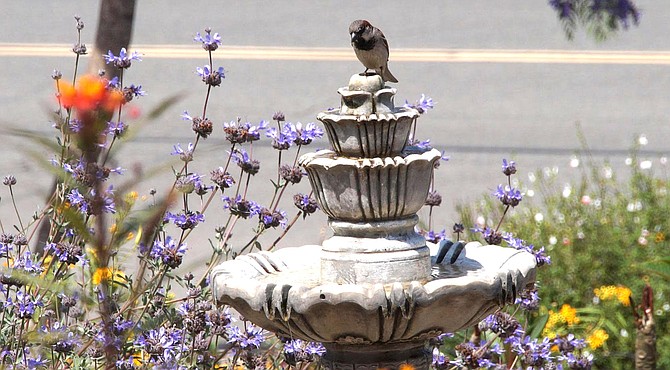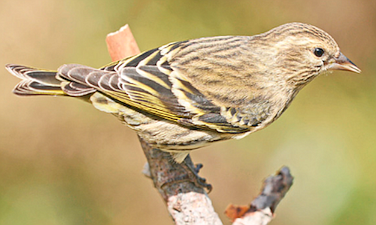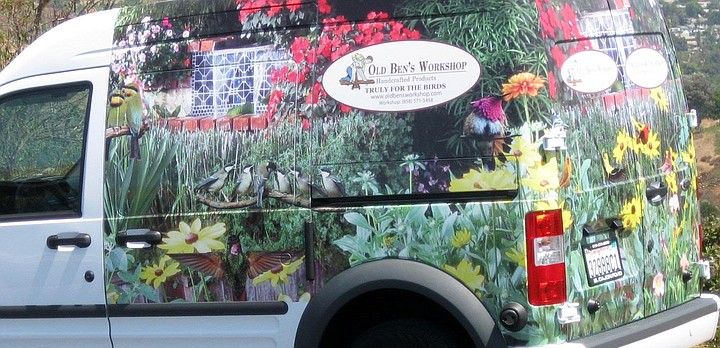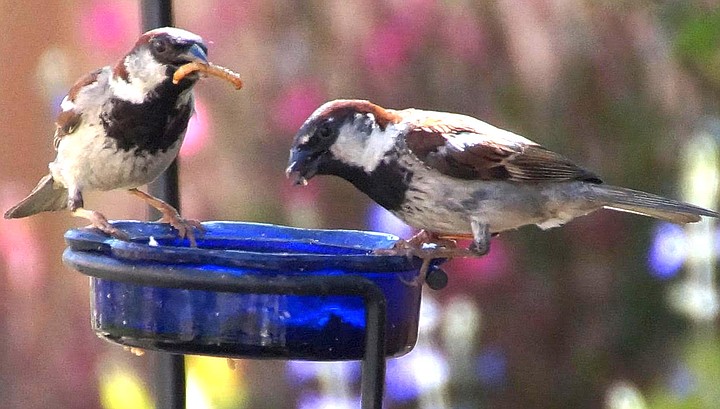 Facebook
Facebook
 X
X
 Instagram
Instagram
 TikTok
TikTok
 Youtube
Youtube

San Diego County dwellers have started to hide their birdbaths and feeders from Salmonellosis-infected birds that might fly in from central and northern California.
"Since December, the California Department of Fish and Wildlife and wildlife rehabilitation centers have been inundated with calls from residents who are finding sick or dead finches at bird feeders," reported the wildlife agency last month. "[The department's] Wildlife Investigations Laboratory has evaluated birds from several locations and determined the cause of illness to be Salmonellosis, a disease caused by Salmonella bacteria."

"I immediately took mine down last week after I found a dead finch near the feeder," posted a bird-lover from Valley Center on Facebook on March 13. "I love my birds and birdbaths," responded her neighbor. "We will take down our stuff for a bit."
According to the agency's report, Pine siskins, a finch species that spends its winters in California, are the primary species impacted by the outbreak. Lesser goldfinches and American goldfinches were affected in fewer numbers.
"These birds are not very common in San Diego County," Benjamin Zlotnick said to me on March 14. "You might find a few in the mountains or North County."

Zlotnick runs a business selling wild bird seed, feeders, and bird accessories from his Tieresante home. For the last 50 or so years, he's been feeding wild birds that fly into his backyard with two koi ponds and birdbaths. "I haven't had any bird deaths in my backyard recently."
Fish and Wildlife added that the recent Salmonellosis outbreak predominantly originates from backyards and locales that have bird feeders and birdbaths.
"Two years ago, there was another problem with house finches infected by an eye disease which they were spreading all over the feeders," Zlotnick continued. "So I posted to my network that they take a ten percent bleach solution to clean [where the birds congregate] and to clean their birdbaths and not to let the feed get moldy. In my opinion, that's what's causing the problem this time around as well."

While the eye disease, avian conjunctivitis, blinds some birds in extreme cases, Salmonellosis brings a sometimes bleaker fate.
"Birds become infected with Salmonella when they ingest food, water or come into contact with objects (e.g., bird feeders, perches, soil) contaminated with feces from an infected bird," explained the Fish and Wildlife report. "Sick birds often appear weak, have labored breathing, and may sit for prolonged periods with fluffed or ruffled feathers."
"Since people were advised to put away their bird feeders and birdbaths until April 1, has this affected your business?" I asked Zlotnick.
"No, we have over 100 products, it's still the same."

Ramie Zomisky, a "backyard birder," suggested something that'll increase sales for local bird shops and worm farms; we Facebook messaged one another on March 15.
"Pine siskins are in San Diego County, but not very common in inner-city areas like Normal Heights. What we have done for years is buy two of each feeder. That way, we can take one down and replace it with a clean one. Then the one we take down gets a good scrubbing, then sits in the sun, away from birds for a couple of days to dry completely. Then we switch the feeders again and re-start the process. Same with birdbaths. We have done this due to other diseases like 'Finch Eye Disease,' which are just as horrible as this Salmonella illness. This time of year, feeder rotation is important because of the weather - this rain and cold can cause molding issues."
The Fish & Wildlife site advises that San Dieagns who can possibly get infected put on gloves when disposing of dead birds or handling and cleaning birdbaths and bird feeders.
Bluebirds, blue jays, orioles, warblers, sparrows, finches, kingbirds, kinglets, phoebes, and towhees regularly visit Zomisky's mid-city backyard. "We have had California thrashers, grosbeaks, cowbirds, waxwings, and a couple of wild budgies. Of course, we get the Hummingbirds, hawks, and other common non-songbirds.
"One thing you might consider is to go more natural. Our birds get a breakfast and dinner of live mealworms. They thrive off the protein, and there is no feeder issue as you would want to clean those bowls daily, and the birds rarely stick around long enough to go potty. They fly in, grab a worm, and get out of Dodge with their yummy treat. But remember that you would have to find a place out of the sun or you'll scorch the worms if the birds are not fast enough. It can be expensive, but their breakfast and dinner times are one of my happiest times of the day as I enjoy them being so happy."
"They're gonna eat their natural food first," Zlotnick said. "Wild birds don't get more than 20 percent of their needs from feeders; they're still out there feeding on their natural habitat."


San Diego County dwellers have started to hide their birdbaths and feeders from Salmonellosis-infected birds that might fly in from central and northern California.
"Since December, the California Department of Fish and Wildlife and wildlife rehabilitation centers have been inundated with calls from residents who are finding sick or dead finches at bird feeders," reported the wildlife agency last month. "[The department's] Wildlife Investigations Laboratory has evaluated birds from several locations and determined the cause of illness to be Salmonellosis, a disease caused by Salmonella bacteria."

"I immediately took mine down last week after I found a dead finch near the feeder," posted a bird-lover from Valley Center on Facebook on March 13. "I love my birds and birdbaths," responded her neighbor. "We will take down our stuff for a bit."
According to the agency's report, Pine siskins, a finch species that spends its winters in California, are the primary species impacted by the outbreak. Lesser goldfinches and American goldfinches were affected in fewer numbers.
"These birds are not very common in San Diego County," Benjamin Zlotnick said to me on March 14. "You might find a few in the mountains or North County."

Zlotnick runs a business selling wild bird seed, feeders, and bird accessories from his Tieresante home. For the last 50 or so years, he's been feeding wild birds that fly into his backyard with two koi ponds and birdbaths. "I haven't had any bird deaths in my backyard recently."
Fish and Wildlife added that the recent Salmonellosis outbreak predominantly originates from backyards and locales that have bird feeders and birdbaths.
"Two years ago, there was another problem with house finches infected by an eye disease which they were spreading all over the feeders," Zlotnick continued. "So I posted to my network that they take a ten percent bleach solution to clean [where the birds congregate] and to clean their birdbaths and not to let the feed get moldy. In my opinion, that's what's causing the problem this time around as well."

While the eye disease, avian conjunctivitis, blinds some birds in extreme cases, Salmonellosis brings a sometimes bleaker fate.
"Birds become infected with Salmonella when they ingest food, water or come into contact with objects (e.g., bird feeders, perches, soil) contaminated with feces from an infected bird," explained the Fish and Wildlife report. "Sick birds often appear weak, have labored breathing, and may sit for prolonged periods with fluffed or ruffled feathers."
"Since people were advised to put away their bird feeders and birdbaths until April 1, has this affected your business?" I asked Zlotnick.
"No, we have over 100 products, it's still the same."

Ramie Zomisky, a "backyard birder," suggested something that'll increase sales for local bird shops and worm farms; we Facebook messaged one another on March 15.
"Pine siskins are in San Diego County, but not very common in inner-city areas like Normal Heights. What we have done for years is buy two of each feeder. That way, we can take one down and replace it with a clean one. Then the one we take down gets a good scrubbing, then sits in the sun, away from birds for a couple of days to dry completely. Then we switch the feeders again and re-start the process. Same with birdbaths. We have done this due to other diseases like 'Finch Eye Disease,' which are just as horrible as this Salmonella illness. This time of year, feeder rotation is important because of the weather - this rain and cold can cause molding issues."
The Fish & Wildlife site advises that San Dieagns who can possibly get infected put on gloves when disposing of dead birds or handling and cleaning birdbaths and bird feeders.
Bluebirds, blue jays, orioles, warblers, sparrows, finches, kingbirds, kinglets, phoebes, and towhees regularly visit Zomisky's mid-city backyard. "We have had California thrashers, grosbeaks, cowbirds, waxwings, and a couple of wild budgies. Of course, we get the Hummingbirds, hawks, and other common non-songbirds.
"One thing you might consider is to go more natural. Our birds get a breakfast and dinner of live mealworms. They thrive off the protein, and there is no feeder issue as you would want to clean those bowls daily, and the birds rarely stick around long enough to go potty. They fly in, grab a worm, and get out of Dodge with their yummy treat. But remember that you would have to find a place out of the sun or you'll scorch the worms if the birds are not fast enough. It can be expensive, but their breakfast and dinner times are one of my happiest times of the day as I enjoy them being so happy."
"They're gonna eat their natural food first," Zlotnick said. "Wild birds don't get more than 20 percent of their needs from feeders; they're still out there feeding on their natural habitat."
Comments